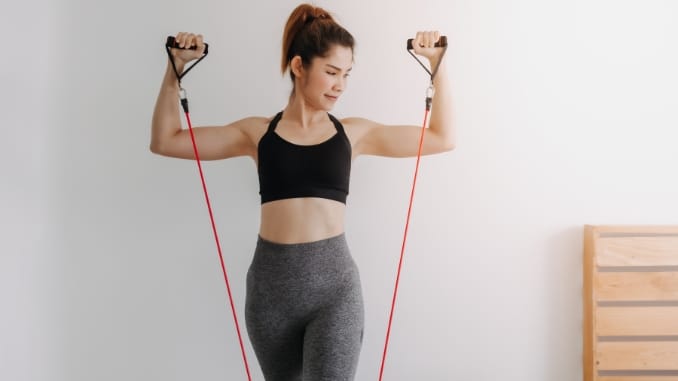If you’ve ever struggled with lifting the same weight through an entire movement, you’re not alone. The truth is, that your muscles aren’t equally strong at every phase of an exercise, which is a limitation of constant resistance training.
This is where variable resistance exercise examples comes in—a game-changing training tool that can help you build strength faster, prevent injury, and optimize power output.
1. Resistance Band Bench Press
Why It Works: You must apply more force at the top of the lift, where you’re strongest.
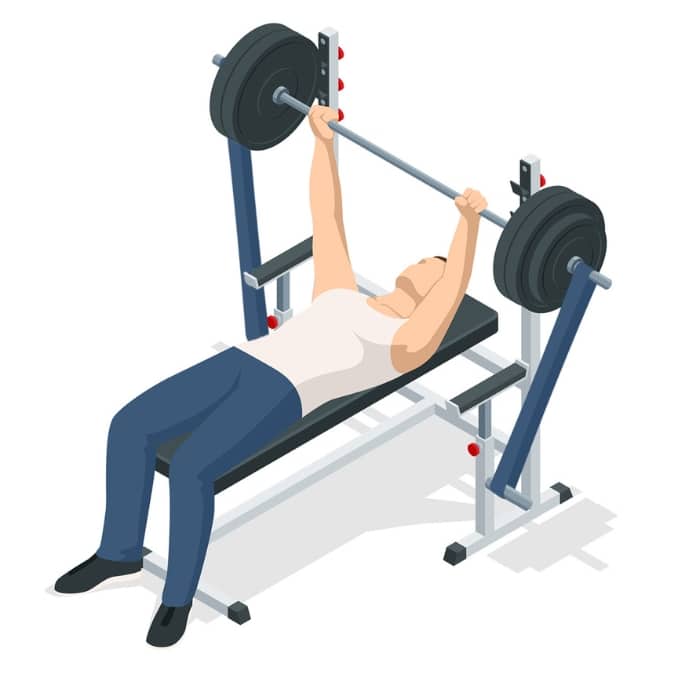
Attach resistance bands to the ends of a barbell or dumbbell to introduce variable resistance.
- Lie on your back on a flat bench with your knees bent and feet flat on the floor.
- Ensure proper alignment throughout your upper body.
- Hold the barbell with a wide underhand grip.
- Tighten your abdominal muscles.
- Inhale and lower the bar slowly until it skims the middle of your chest.
- Push the bar back to the starting position explosively as you exhale.
- Focus on pushing the bar using your chest muscles.
2. Squats with Bands or Chains
Why It Works: Targets the weakest position, making your legs work harder.
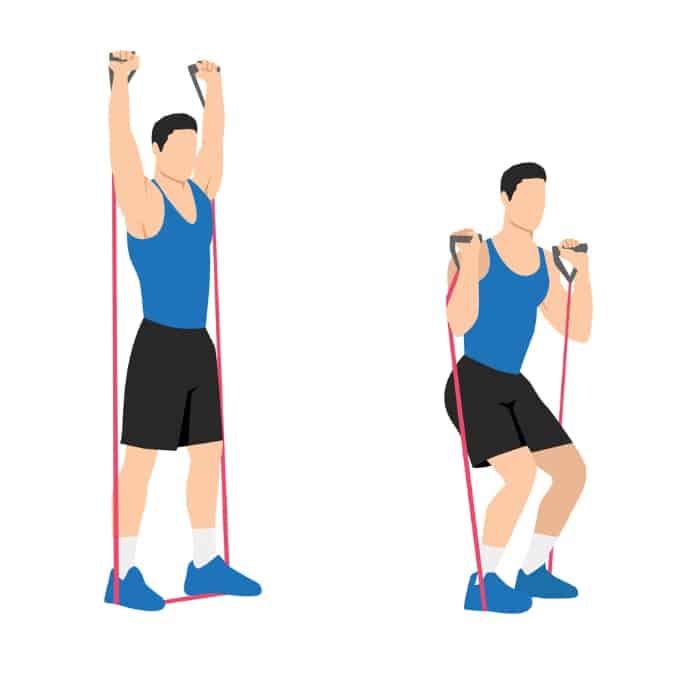
- Begin in an upright standing position with your feet shoulder-width apart, and maintain good alignment with your head, shoulders, hips, and legs.
- Position both feet on the center of the resistance band while gripping each end firmly with your hands.
- Engage your core muscles.
- Lift both arms overhead, creating resistance to the band.
- Then, bend both knees to lower your upper body into a squat position as you lower your arms at shoulder level.
3. Single Leg Deadlift with Bands
Why It Works: Forces maximum effort through the entire movement, maximizing force production.
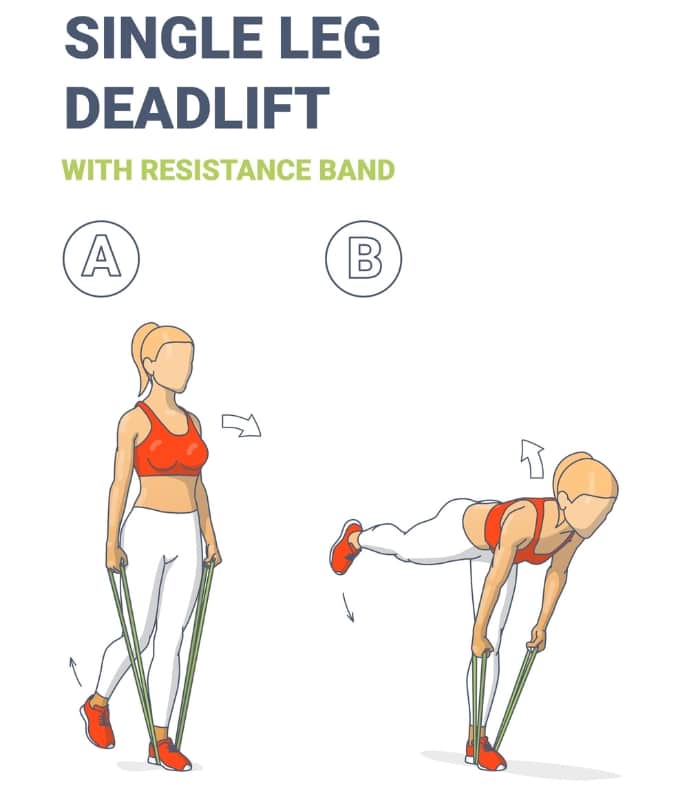
- Begin in an upright standing position with your feet hip-width apart, and maintain good alignment with your head, shoulders, hips, and legs.
- Step one foot on the middle of the resistance band and hold both ends with each hand.
- Place your arms on the side.
- Engage your core muscles.
- Shift your weight onto one leg.
- Hinge through your hips to bend your upper body forward, ideally parallel to the floor, while extending your opposite leg back.
- Hold the position for a couple of seconds.
- Relax and repeat the movement on the opposite side.
4. Tricep Extensions with Resistance Bands
Why It Works: Helps target muscular strength and endurance while reducing shoulder pain.
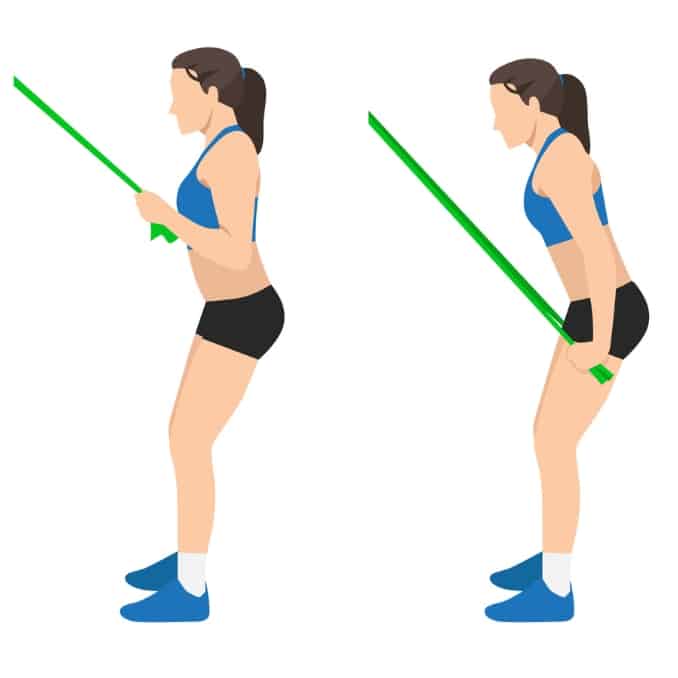
For this exercise, use a resistance band anchored above the door frame or a wall.
- Begin in an upright standing position with your feet hip-width apart, maintaining good alignment with your head, shoulders, hips, and legs.
- Hold the ends of the resistance band with each hand at chest level.
- Engage your core muscles.
- Slightly bend your knees and pull your arms down, creating resistance to the band.
- Hold the position for a couple of seconds and return to the starting position.
- Repeat the movement with 10 repetitions.
5. Chest Press with Bands
Why It Works: Increases muscle activity throughout the concentric portion.
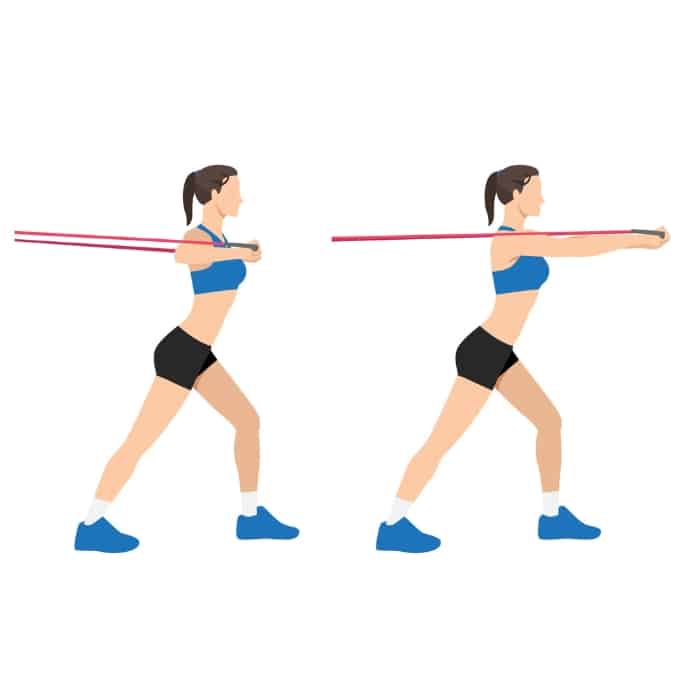
For this exercise, use a resistance band anchored on a wall.
- Begin in an upright standing position with your feet hip-width apart, and maintain good alignment with your head, shoulders, hips, and legs.
- Hold the ends of the resistance band on each hand and bend your elbows on the side at chest level.
- Bend your front knee and engage your core muscles.
- Extend your arms forward, creating resistance to the band.
- Hold the position for a couple of seconds.
- Bend your elbow back to return to the starting position and repeat the movement with 10 repetitions.
What Is Variable Resistance Training?
Variable resistance training (VRT) [1] involves resistance that changes dynamically throughout a movement, unlike the static resistance provided by free weights. Traditional weight training typically involves static resistance, which can limit strength gains.
This type of training uses elastic bands, chains, or specialized workout equipment to ensure the maximum amount of effort is applied in every phase.
Unlike conventional weightlifting, where you struggle at the weakest part, VRT lets you add variable resistance to improve efficiency and safety.
The Difference between VRT and DVRT
Variable Resistance Training (VRT) involves resistance that changes dynamically during movements, using tools like elastic bands and chains to enhance strength throughout the exercise.
Dynamic Variable Resistance Training (DVRT) Dynamic Variable Resistance Training (DVRT), created by Josh Henkin, is designed to enhance functional strength using variable resistance techniques. This specialized form of Variable Resistance Training (VRT) adjusts resistance based on body position, emphasizing functional strength and improving movement patterns.
While VRT encompasses a range of resistance methods, DVRT specifically targets optimal muscle engagement and stability for real-life movements.
Variable Resistance Exercise Examples (How to Do Them)

Depending on your training goals, experience level, and equipment availability. Each form of variable resistance [2] —barbells, bands, and chains—has unique benefits: While traditional methods require you to lift weights with constant resistance, variable resistance exercise examples adjust the load throughout the movement.
Which Should You Use?
- For raw strength & power: Use barbells + bands or chains. Combining bands or chains with free weight exercises can maximize strength and power gains.
- For speed & explosiveness: Use bands alone or bands + barbells.
- For rehab, mobility & convenience: Use resistance bands only.
Benefits of Variable Resistance Training
- Enhanced Strength Gains – Facilitates greater strength improvements compared to lifting static weights alone.
- Improve Muscle Growth – Enhances force production throughout the entire range of motion.
- Injury Prevention – Minimizes joint stress in the most vulnerable phases of a movement.
- Increases Power Output – Trains you to apply more power throughout the full range.
- Improves Weak Points – Addresses the weakest point of a movement.
- More Efficient Workouts – Eliminates plateaus by adding accommodating resistance.
- Suitable for All Fitness Levels – Effective for beginners, seasoned athletes, and rehabilitation patients.
How to Add Variable Resistance to Your Workout Program

- Use Bands or Chains: Attach resistance bands or chains to barbell lifts.
- Switch to Elastic Resistance Training: Replace some free weights with elastic bands.
- Modify Bodyweight Exercises: Add bands to bodyweight exercises like push-ups.
- Focus on the Concentric Phase: Apply more resistance in the concentric portion for maximum gains.
- Adjust Weights for Peak Power: Use accommodating loads to match your peak force.
Should You Try Variable Resistance Training?
If you want better strength gains, more power, and improved muscle growth, variable resistance training [3] exercise examples is a must.
Even strength experts like John Jaquish emphasize its impact on conditioning research. It’s an easy way to improve strength, push through plateaus, and take your workouts to the next level.
Start adding variable resistance today, and watch your progress skyrocket!
Don’t wait any longer to get the toned, sleek arms you’ve always dreamed of. Check out this Tone & Tighten Arm Workout now!
Frequently Asked Questions
How does variable resistance exercise work?
It adjusts resistance throughout the movement, providing more challenge where you’re strongest and less where you’re weakest, improving muscle activation.
What differentiates variable resistance from traditional weightlifting?
Unlike statics weights, variable resistance changes the load dynamically, making it more effective for strength gains and reducing joint strain.
Are variable resistance exercises suitable for home workouts?
Yes! Exercises like banded squats, resistance band push-ups, and cable machine curls can be done with minimal equipment at home.
What equipment is used for variable resistance training?
Equipment includes resistance bands, chains, cable machines, and specialized machines like plate-loaded variable resistance machines.
Who should use variable resistance training?
Athletes, bodybuilders, and rehab patient benefit from it, but anyone looking to build strength, improve mobility, or reduce joint stress can use it effectively.

